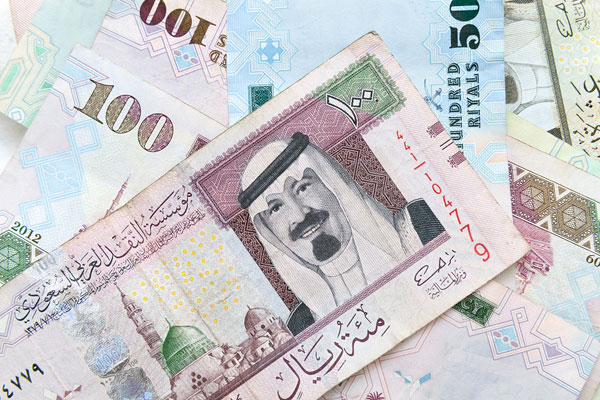
Saudi Arabia’s financial might is expected to draw
investors to the new issue.
Saudi international bond likely to get ‘warm welcome’
, December 22, 2015
By Karin Strohecker
Saudi Arabia's debut international bond should get a warm welcome from foreign investors if it hits markets in 2016, though fund managers say they will need yields that compensate them for the political and oil price risks.
The kingdom has been burning through its hard currency stash as oil prices fall -- at the last count, in September, reserves were almost $100 billion, or 12 per cent, less than a year earlier.
With its currency tied to the dollar and a budget deficit topping $100 billion this year, Saudi Arabia has options for plugging the deficit such as cutting some of the cradle-to-grave benefits it provides to citizens, raising taxes or borrowing.
Cuts have been mooted. Other reforms, including privatisations, may be unveiled soon in the state budget.
But banking industry sources told Reuters last month the government would also sell bonds issued by the central bank, the Saudi Arabian Monetary Agency (SAMA), as soon as next year. The international bonds will be of "substantial benchmark size" and a likely 10-year maturity, they added.
Despite its political and economic problems, the kingdom's financial might - almost $700 billion in reserves and debt ratios that are among the world's lowest - is expected to draw investors to the new issue.
"It is a country that has massive reserves, so there is no risk of default in the foreseeable future, and it has good diversification as well for EM (emerging markets) funds and investors, so there definitely will be demand," said Regis Chatellier, director EM sovereign credit strategy at Societe General.
Investors are not concerned by the Saudi bond's likely exclusion from the main emerging sovereign bond benchmark, JPMorgan's EMBI Global, because of its high credit rating and per capita income.
"It is an off-benchmark play, but so is Qatar and that hasn't deterred us in the past," said Kevin Daly from Aberdeen Asset Management.
Details of timing and size should be revealed in the state budget but the bond is expected to be large -- possibly $10 billion or more, given the kingdom's huge financing needs.
Saudi has already returned to domestic bond markets for the first time since 2007; since July it has been issuing about 20 billion riyals ($5.3 billion) every month.
This week's sale will bring total issuance to 115 billion riyals. Coming in five-, seven- and 10-year maturities, these bonds, sold to local banks, yield between 1.95-2.85 per cent.
OIL PRICES KEY TO YIELD
Yield on the international bond will be determined to a large extent by oil prices, said Sergei Strigo, head of emerging debt at Amundi.
Oil rose to nearly $70 a barrel in May before falling to around $36 this week.
"If we go to $20 a barrel the yield spreads could be hundreds of basis points (bps) wider than they are now, but if it's at $50 we can talk of 200-250 bps over US Treasuries," Strigo said.
For guidance, funds will use Saudi Arabia's sovereign credit rating as well as yields on bonds from state-controlled Saudi Electric and credit default swaps (CDS), derivatives used to insure against debt default.
Saudi Arabia holds a AA/Aa3 credit rating, assigned to it by Fitch and Moody's respectively, two-three notches below the top AAA grade but far above most other developing countries.
Analysts at Oxford Economics calculate that while debt from countries with an AA rating would trade at 50 bps over equivalent-maturity US Treasuries, Saudi Arabia might have to pay a 100-120 bps premium.
That is because, first, Saudi Arabia should also pay a higher yield than Qatar, another energy-rich Gulf state which is rated a notch higher, Oxford Economics said.
Qatar's dollar bond maturing in 2022 trades at a spread of 77.43 bps over relevant Treasuries or a 2.933 per cent yield .
Second, there is risk of ratings downgrades for Saudi Arabia. Standard & Poor's cut it a notch to 'A-plus' in October while both Fitch and S&P have negative outlooks on the rating.
Saudi CDS also rose steadily to hit six-year highs last month, after being quoted between 58 bps and 78 bps until mid-August.
"Investors will look not at current ratings but at future ratings," said Claudia Calich, head of emerging debt at M&G Investments, noting the challenges facing the kingdom.
Apart from oil prices, Saudi Arabia must deal with succession issues in the royal family, tensions with it's Shi'ite minority and the risk of Islamist militancy among disaffected youth.
"The country has a number of issues; oil prices, infrastructure spending -- so the fiscal commitment is pretty high -- and they are fighting a war, so they have a lot of things that they have to deal with internally," said Scott Thiel, deputy CIO, Fundamental Fixed Income at BlackRock.
But Thiel said investors would be keen to see a programme of regular bond sales from the kingdom, boosting liquidity in the issues. Such a bond would also provide a benchmark for other upcoming issues from the Gulf, with a series of other countries planning to tap bond markets in coming years.
"If they (Saudi Arabia) are committed to an issuance programme over a certain duration, for us that is better than if they just do a one-off issuance," Thiel added. – Reuters







